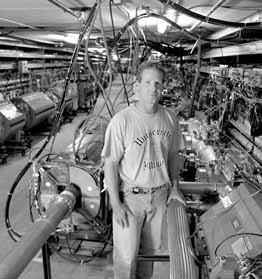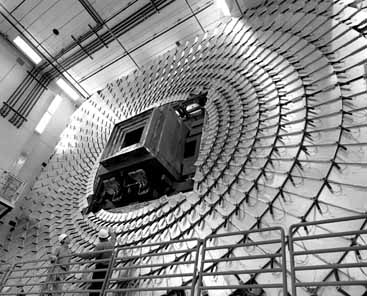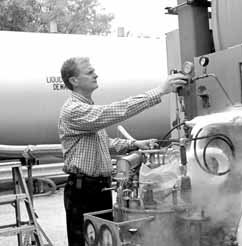 |
|
Engineering Run II by Judy Jackson
The pyramids. The Eiffel Tower. The Brooklyn Bridge. The Empire State Building. When it comes to engineering marvels, Run II at the Tevatron is up there with the Wonders of the World.
Until now, no one has ever built anything like this creature of steel, plastic, fiber, helium, superconductor, glue, silicon, scintillator, water, electricity, gas; this assemblage of microcircuits, magnets, lasers, cables, valves, pumps, chillers, controls, tanks, pipelines, vacuum systems, phototubes, wave shifters, light pipes, targets, electronics, cooling, heating, input and readout, data acquisition and analysis; this engineering phenomenon called Run II.
Fermilab engineers and their colleagues at laboratories and universities around the world have worked for nearly a decade to create accelerators and detectors that--until now--never were, so that Fermilab scientists can search for what is, at the smallest scale human beings have ever seen. Run II at the Tevatron represents not only the start of a new scientific quest, but also the culmination of an almost unimaginable engineering effort.
Run II embodies the solutions to thousands of engineering challenges of extraordinary variety and scope. To build Run II, engineers have designed electronic chips with channels of circuitry so tiny they make a human hair look huge; and they have hoisted hundred-ton hunks of steel high in the air. To raise the Tevatron's energy, they have lowered its operating temperature and in the process doubled the size of the world's largest helium liquefier. They have calculated, tested, measured, recalculated and retested. They have gone to Plan B, and Plan C, and sometimes back to Plan A. Each engineering problem solved is a story: the choice of one material over another; the discovery of exactly the right glue to hold a fiber bundle in place; the formation of a rigging crew; the design of a magnet lattice to cool a stack of antiprotons; the bookkeeping to track hundreds of components as they come to life across the globe; the art of fitting tab A into slot B as the components converge in a 5,000-ton detector.
It would take a dozen issues of FermiNews to tell all the stories of the engineering of Run II. The case studies that follow give a flavor of what it takes to build what never was, the accelerators and detectors for the physics that is, at the energy frontier.
Ray Yarema, Particle Physics Division
At the heart of the new CDF and DZero detectors, the latest generation of silicon vertex detectors will track trillions of high-energy proton-antiproton collisions, searching for the displaced "v"s that mark the decays of b quarks. Mounted on the detectors' silicon strips are thousands of new-generation electronic chips that record and read out the data for each collision. Fermilab engineer Ray Yarema led the design of the Run II SVX chips at Fermilab.
"Run II presented designers with many more collisions per second to record and read out," Yarema said. "The challenge was to design a chip that would operate at a much higher collision frequency."
Then, halfway through the chip design process, CDF presented Yarema with still another challenge.
"Rather than separating signal acquisition from data readout operations, CDF wanted a chip that would do both simultaneously," Yarema said. "That was a serious problem because the on-chip digitization, data compression and readout functions would generate noise that was picked up by the very sensitive analog parts of this chip."
Yarema's team came up with a new idea. They plated the back side of this chip and used it as a power supply ground connection to reduce the noise problem.
Each chip has 128 channels, each one about 42 microns wide. For comparison, a human hair has a width of about 75 microns. Yet, said Yarema, the microscopic dimensions are not the only thing that made the process a challenge.
"One of the most difficult things in chip design is defining what needs to be done," he said. "Expectations are often too high. Part of the process is defining the achievable, then trying to do it. It takes time to define the problem you are trying to solve."
Harry Carter, CDF
"It was like hanging a locomotive from the ceiling," Carter said.
Carter and his team used a gantry to raise the steel 39 feet in the air, where it swung back and forth a bit before attachment to the ceiling.
"ëOh,' the riggers told me, `that's what we call the gantry dance,'" Carter said. "It impressed even me."
"CDF's an excellent detector," Carter said. "It will take a little time to get it working the way we want, but we all feel confident that we will get there."
Dave McGinnis and Ralph Pasquinelli, Beams Division
"The challenge is to make more and better antiprotons for Run II," said Fermilab scientist Dave McGinnis, head of the Pbar Source. "The point of the whole Main Injector upgrade was to make more antiprotons. Okay, they made it work. Now it's up to us to handle the increased flux."
To do that, McGinnis and his team, in partnership with Fermilab engineer Ralph Pasquinelli and the Stochastic Cooling Group, overhauled the pbar cooling, the complex system that creates a beam of antiprotons all moving in the same direction with the same momentum, in the pbar storage ring.
"In the pbar source," McGinnis said, "we use stochastic cooling, not electron cooling. Electron cooling is like putting a cold cup of coffee next to a hot cup of coffee to cool it off. Stochastic cooling is like taking green paint and separating it into blue paint and yellow paint. You have to talk to each particle individually. `Hello? Where are you? If you're not in the right place, would you please go to the right place immediately?' The more particles you have, the faster you have to talk."
Pasquinelli echoed the need for speed.
"We had to do faster pbar cooling. The flux of pbars is up, so we had to take the cycle time from 2.4 seconds to 1.5 seconds. We had to get to cooled beam in 1.5 seconds."
To do that, McGinnis and Pasquinelli reconfigured the lattice, or arrangement of magnets and other components in the pbar storage ring, adding new diagnostics, beam position monitors and other instruments. They installed a free-space laser to transmit signals to the circulating antiprotons. Now they are working on improving the ability to stack antiprotons for injection.
"Our goal," Pasquinelli said, "is to reach 15 to 20 milliamps per hour stacking rate. The old Run I record was seven milliamps per hour. Both Dave and I hope to break that record before the end of the summer."
It won't be simple.
"Running a pbar collider is a five-ring circus," McGinnis said. "There is an art and craft to handling pbars. If you are using protons, you can always get more; but when you are dealing with pbars you have to be careful. Pbars are a precious commodity."
"Integration is the art of fitting what has to fit into the space available," said Fermilab engineer Andy Stefanik, who had the challenge of making the DZero muon system fit together--and of fitting it into the collision hall. "We did an incredible amount of surveying and measuring."
To roll into the collision hall, the detector had to fit under a concrete lintel beam separating it from the assembly hall.
"Early on," Stefanik said, "the project manager told me that the gauge we would use to fit the detector into its space in the collision hall would be my finger. If it hadn't made it, I would have been up there chipping concrete."
Stefanik's plans left a small but non-zero margin for error, and the detector made it under the lintel.
"You can afford to take more risk if you have a back-up plan. If not, you have to be more conservative," Stefanik said. "If the detector had not fit into the collision hall, it would have been a showstopper."
Bob DeMaat, CDF
While Stefanik struggled with the mechanical fit at DZero, Fermilab engineer Bob DeMaat was trying to make everything come together electronically at CDF.
"The electronics at CDF were designed and built by people at institutions located throughout the world," DeMaat said. "The challenge is to coordinate their work and make sure that it will all function together. The first question is, Will a subsystem's operation be hazardous to the health of the experiment? It's one thing to design something that works as an island, and something else to design it for electrically quiet operation that won't interfere with other components. One rule is that no subsystem is allowed to drive currents through the steel of the detector. Other subsystems are sensitive to that."
Questions of electrical distance, of cable length, also come into play, DeMaat said. In Run II, many more electronics systems are mounted on the detector itself, with more channels and more chips. What will be located on the detector, and what can run at a distance? And what will moving the detector from the assembly area to the collision hall do to the carefully configured electronics?
"The vast majority of the electronics made the move without a problem," DeMaat said.
He values the interaction between the physics goals of the experiment and the technology that makes it work.
"The partnership between physicists and engineers is critical," DeMaat said. "There are physicists who dabble in engineering. But there are also physicists who like engineering and who are really good at it. They are invaluable. You need a combination of engineers with an understanding of the physics of the experiment and physicists who understand the engineering. They have a feeling for the technology that will work."
Bill Cooper and Dan Olis, DZero
"There's a tight linkage between the engineers and the experiment's physicists," Olis said. "It would be a mistake not to have constant communication. Otherwise, you could be going down a primrose path."
Cooper and Olis have concentrated their efforts at the core of the DZero detector.
Heat from the operation of readout chips in the silicon microstrip detector raises the temperature of the silicon, which is designed to operate at a temperature of below zero degrees centigrade. Cooper and his team designed and built a coolant system that circulates a ñ10ƒC. ethylene glycol and water mixture through the hollow beryllium framework of DZero's silicon vertex detector. To avoid the possibility of coolant leaking onto the silicon system, the coolant is kept below atmospheric pressure. The coolant circulation is designed to use a minimum of controls, relying instead on the physics of the beryllium passages to determine pressure and heat transfer.
"The sizing of the passages was critical," Cooper said. "DZero has just two controls on the silicon cooling system. Other than that, control is achieved through the physics of fluid and thermodynamics."
Because it is hard to seal off the cold SVX, frost could form on the cables and other components. To prevent frost build-up, Olis designed a system that uses a compressor to provide a continuous flow of 50 cubic feet per minute of dry air, with a back-up mechanism in case the compressor fails.
"If you are an engineer," Olis said, "you feel there must be a solution to a given problem. Hopefully, you can find the simplest, most elegant and cheapest one. If that doesn't work, you look for another approach."
Maurice Ball, Beams Division
"The goal is for the water system to work with increased reliability and improved monitoring for the MCR operators," Ball explained. "The operators let me know what they wanted, so I could design a system for them. The last thing we want operators to have to worry about is water."
Thanks to new flow controls, a new temperature control system, new pressure and flow sensors and new wiring, they shouldn't have to worry.
Ball is so thoroughly immersed in water problems, he says, that colleagues wonder if he dreams of low-conductivity water at night. He and his crew have nearly completed the new Tevatron system, and he is eager for full-scale collider operations at the accelerator.
"I just like to watch it hum," Ball said.
Jay Theilacker, Beams Division
"Superconducting magnets perform better at lower temperatures," said Fermilab Engineer Jay Theilacker, head of the Beams Divisions Cryogenics Department. "You can get the best performance out of every magnet by lowering the temperature as much as possible. To do that, you lower the pressure in the two-phase system, to make the helium boil at a lower temperature."
Lowering the pressure meant developing new technology in the form of a centrifugal helium co-compressor, designed in partnership with a Japanese firm. During the Tevatron's engineering run in Fall 2000, "everything ran well," Theilacker said. "So far in Run II, the temperatures are lower and the energy is higher."
To meet the new cooling demands, Theilacker's group upgraded Fermilab's Central Helium Liquefier. Originally designed to be used as a back-up facility, CHL has become essential to Fermilab's accelerator operations.
"We essentially built a second CHL," Theilacker said. "We built Cold Box Two, identical to the original Cold Box One, but with bigger turbines for more capacity. Then we replaced the turbines in Cold Box One, to regain redundancy. We upgraded the pressure vessels and relief valves to run CHL at higher pressure for more capacity and greater efficiency. Either one of our cold boxes alone is easily the world's largest helium liquefier. It took the dedication of the entire Cryogenic Department for over a decade to get to where we are today."
To build Run II and make it work, engineers at Fermilab and around the world have solved thousands of problems like the ones in these case studies. In doing so, they have created something extraordinary: the most powerful opportunity for discovery in particle physics in the world. |
| last modified 5/10/2001 by C. Hebert email Fermilab |
FRLsDFx9eyfrPXgV
 While Yarema measured his problems in microns, Fermilab engineer Harry Carter calculated his in tons. As engineering leader of the "I and I" group responsible for mechanical infrastructure and installation of CDF components, one of Carter's first jobs was to lift a 100-ton chunk of steel muon shielding and hang it from the ceiling of CDF's collision hall.
While Yarema measured his problems in microns, Fermilab engineer Harry Carter calculated his in tons. As engineering leader of the "I and I" group responsible for mechanical infrastructure and installation of CDF components, one of Carter's first jobs was to lift a 100-ton chunk of steel muon shielding and hang it from the ceiling of CDF's collision hall.
 When CDF gets there, so will many more particle collisions than the Tevatron has ever delivered before. The keys to the increased collision rate are antiprotons.
When CDF gets there, so will many more particle collisions than the Tevatron has ever delivered before. The keys to the increased collision rate are antiprotons.
 At DZero, space is a precious commodity.
At DZero, space is a precious commodity.
 At DZero, Bill Cooper is a physicist who likes engineering, working in partnership with Dan Olis, an engineer who has his eye on the physics.
At DZero, Bill Cooper is a physicist who likes engineering, working in partnership with Dan Olis, an engineer who has his eye on the physics.
 Fermilab engineer Maurice Ball took another approach to cooling, optimizing the low-conductivity water systems that cool magnets in the Main Injector and Tevatron. He and his team wanted to make sure that the operators in the accelerator's Main Control Room would always know what the critical water systems were doing.
Fermilab engineer Maurice Ball took another approach to cooling, optimizing the low-conductivity water systems that cool magnets in the Main Injector and Tevatron. He and his team wanted to make sure that the operators in the accelerator's Main Control Room would always know what the critical water systems were doing.
 In Collider Run II, the Tevatron will be humming at the highest energy it has ever achieved, 1.96 trillion electron volts, in contrast to Run I's 1.8 TeV. The energy went up because the temperature went down.
In Collider Run II, the Tevatron will be humming at the highest energy it has ever achieved, 1.96 trillion electron volts, in contrast to Run I's 1.8 TeV. The energy went up because the temperature went down.